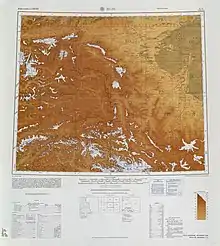Posgam
English

Map including TSE-P'U (POSGAM) (AMS, 1966)
Pronunciation
- enPR: pōsgämʹ
Proper noun
Posgam
- Alternative form of Poskam
- 1923, Ghulam Rassul Galwan, Aksakal of Leh, Servant of Sahibs, Cambridge, England: W. Heffer & Sons Ltd., →OCLC, page 43:
- There, late afternoon, got back to Yarkand city. When came there, did not stop; came by the long road. All the time go very fast. I run with them very fast, same a slave. That evening reached to Tegarchi Bazaar. I hope there must camp. Did not camp. From that place was to Posgam about twenty miles. That time was very tired and hungry. I did try to buy some bread. The Hindu not let me buy. The Hindu get very angry with me about the bread. I walking with them very fast again. Got too dark; not see way.
- 1947, K. P. S. Menon, Delhi-Chungking: A Travel Diary, Oxford University Press, →OCLC, page 86:
- Posgam, Friday, 6 October
We left Yarkand for Posgam at about 10. Today's 17-mile drive from Yarkand to Posgam gave us no indication that we were on the edge of the desert. On both sides of our road were double rows of poplar, interlined by an irrigation channel. And everywhere there were fields of wheat, maize and cotton.
- 1976, Chuen-Yan David Lai, “Developments of Cotton Cultivation in Sinkiang”, in Pacific Viewpoint, page 162:
- In the western part of the Tarim Basin, cotton is grown mainly between the K'a-Shin-ka-erh (Kashgar Darya) and Yeh-erh-ch'iang (Yark and Darya) rivers where the growing season is longer and population denser. The main centres are K'a-shih (Kashgar), Pa-ch'u, Yüeh-p'u-hu, Mai-kai-t'i (Merket), So-ch'e (Yarkand) and Tse-p'u (Posgam).
- [1986, Gronke, Monika, “The Arabic Yārkand Documents”, in Bulletin of the School of Oriental and African Studies, volume XLIX, number 3, School of Oriental and African Studies, →ISSN, →OCLC, page 491:
- Posgām (in Arabic letters written Būskām) is a large town to the southeast of Yārkand, situated on the trade route coming from Karġalik (today: Yeh-ch‘eng) at a distance of 21 miles from Karġalik. Posgām is the modern Tse-p‘u.]
-
Further reading
- Leon E. Seltzer, editor (1952), “Posgam”, in The Columbia Lippincott Gazetteer of the World, Morningside Heights, NY: Columbia University Press, →OCLC, page 1510, column 1
- Lattimore, David (1994), “Table of Names”, in High Tartary, Boston: Little, Brown, and Company, →ISBN, →LCCN, →OCLC, page 373: “Usage in High Tartary / Current Usage in Pinyin Transliteration / Name and Other Common Usages […] Posgam / Zepu / Tse-p’u Poskam”
Anagrams
This article is issued from Wiktionary. The text is licensed under Creative Commons - Attribution - Sharealike. Additional terms may apply for the media files.